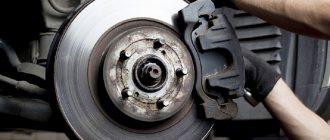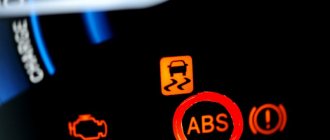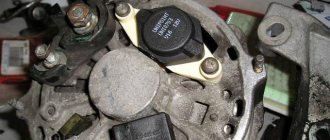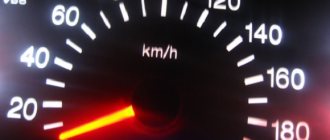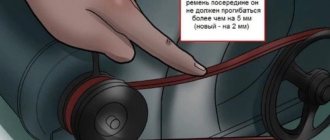The car's dashboard contains sensors and warning lights that monitor the operation of the car's engine and a number of other systems responsible for traffic safety. This includes the brake system warning light. When the ignition is turned on, this lamp lights up, but after the engine starts, it goes out, which indicates the normal state of the braking system.
But drivers face this problem when the brake warning light comes on while driving. Moreover, it can light up constantly, flashing (haphazardly), only when the brake pedal is depressed. And this may already partially indicate where to look for the reason for this behavior of the signal lamp.
Why is the brake light on?
But let's start with the design features of the brake system alarm. Previously, cars used only one sensor - the level of brake fluid in the system, which sent a signal to the warning lamp. Since fluid is the main working element of the system, and its leakage leads to the brakes stopping working, naturally, the designers installed a sensor to monitor the level.
Additionally, the car also has a parking brake, the use of which must be monitored by the driver. On some models, the warning lamps for the working and parking systems are separated. The warning light with an exclamation mark in a circle is responsible for the fluid level, and the indicator marked with the letter “P” signals that the handbrake is engaged, and it turns off after the car is released from the handbrake.
But often a car has only one warning light, to which both the liquid level sensor and the handbrake sensor are “attached”.
Modern cars use circuits that additionally include brake pad wear sensors and brake light lamps. Failure of these elements causes the lamp on the dashboard to light up.
There are other design nuances that cause the indicator to glow. On VAZ models of the 10th family of the first years of production, a starter protection relay was included in the circuit, which forcibly turned it off after starting the engine. In this circuit, the designers connected the power supply circuit for the brake system lamp to this relay. As a result, when the relay breaks down, the lamp begins to burn constantly. There are many constructive nuances. And the more complex the circuit, the more difficult it is to identify the cause of the breakdown.
Why does the brake warning light on the dashboard come on or does not go out after starting the engine? If this happens while moving, it is better to stop moving and carry out diagnostics. If the light does not go out after starting the engine, it is better not to drive until the problem is resolved.
Electronic signaling devices
Manufacturers equip all modern cars with such sensors, considering them more advanced. Indeed, thanks to such alarms, it became possible to control the fact of not only complete wear, but the degree of depreciation of the friction material. This is facilitated by the fact that electronic signaling devices began to be divided into two types:
- External sensors – mounted on the side of the brake bar or in a recess specially designed for them. This allows, in the event of a breakdown, to replace them.
- Integrated devices - pressed into the friction material during the production of the strips. In this case, replacing them is impossible.
Such indicators are designed simply: there is a core in a plastic case; in order not to damage the brake disc, it is made of soft types of metal. On the back of the device there is a connector with a lead wire.
The principle of operation of such sensors is based on the processes occurring in the electrical circuit when it is closed. When the core, due to wear of the strips and destruction of the front part of the body, begins to touch the disk, the same processes occur. The contact circuit closes and the indicator on the dashboard lights up.
The result of the external and integrated sensors differs slightly in the signal that appears on the instrument panel:
- When an external sensor is triggered, the light indicator lights up at the moment when the thickness of the friction material has reached its critical point and lights up constantly in one color.
- In the case of an integrated indicator, the indicator light changes color depending on the wear of the pads. When the thickness of the friction layer approaches critical values, it begins to glow yellow. And when the friction material is completely worn out, when immediate replacement of the pads is required, the light turns red.
It is not difficult to understand the principle of how such a multi-level scheme works. As already mentioned in the article covering the issue of “when should brake pads be replaced,” the friction layer of many brake pads contains metal additives. Thanks to this, they can, although with high resistance, pass electric current. These properties were used by manufacturers to determine how soon the linings would wear out. The thickness of the friction layer plays an important role in the electrical resistance of the lining (the thinner the layer, the lower it is).
When the ignition is turned on, an electronic circuit is formed, the circuit of which consists of an indicator, wires, a sensor and a brake disc.
When, as a result of partial wear of the friction layer, the resistance in this circuit decreases to a certain percentage, a yellow light comes on. Which signals that the bar will still serve for a certain period of the car's mileage, but its complete wear is just around the corner and you should take care of purchasing new pads. Well, if the color of the indicator changes from warning yellow to red, immediate replacement of the strips is required.
What should I do if the brake light on the instrument panel is on?
Checking the mechanical component
Self-diagnosis is a simple operation. It is divided into two components - mechanical and electrical. The first is very important, since it evaluates the condition of the brake system drive and determines its performance.
Checking the mechanical component is reduced to assessing the level of brake fluid in the reservoir and the condition of the drive lines and system components - the master brake cylinder and operating mechanisms.
The brake reservoir is located in the engine compartment, on the right near the rear panel of the engine compartment. It is not difficult to find it, since there are two wires going to the tank cap.
When checking, disconnect the wires and unscrew the cap to determine the brake fluid level. There are marks on the walls of the tank, by which you can understand how much liquid is left. A level above the middle between the marks is considered normal.
A drop below o indicates a fluid leak. Therefore, the next stage is checking the lines and brake mechanisms. To do this, inspect the wheels from the inside. If we find a fluid leak from the mechanisms, then we see smudges on the disks.
For an additional check, we start the car and press the brake pedal a couple of times, after which we roll the car back and inspect the surface of the ground for traces of leaking fluid, and check the fluid level. If it is detected, the brake line is damaged, and the amount of fluid will decrease.
If there is a brake fluid leak, the car cannot be used because the car does not have brakes. The best option in this case is to call a tow truck to deliver the car to the repair site. But if you have enough driving experience, then we get to the service station or garage on our own. Car brake systems usually have two circuits, and if the line of one of them is broken, the second continues to work. But due to the fact that the effectiveness of the brakes on a car with a damaged line is greatly reduced, you need to drive at low speed and with the hazard lights on.
Sometimes there is a problem with the warning light coming on when you press the brake pedal. The reason for this lies in two factors - low fluid level in the reservoir and worn disc brake pads. When braking, fluid flows into the working cylinders and the amount in the tank drops below a critical level, which is why the lamp lights up. This can be treated by installing new pads and adding fluid to the reservoir.
Electrical problems
If upon inspection it is revealed that the lines and working elements of the system are not leaking, then we look for the cause in the electrical component. And since it performs a signaling function, the operation of the car continues as usual. But you should not delay in identifying and eliminating the problem, since in this case the warning light will not work in case of a serious malfunction - a liquid leak.
And problems with the electrical part arise in:
- liquid level sensor;
- handbrake signal sensor;
- brake lamps;
- brake pad wear sensors.
The reason is also the wiring that leads to the listed elements.
A malfunction of the liquid level sensor occurs when the contacts to which the wiring is connected are oxidized and the float is broken down (if it is hollow). In the first case, contact between the sensor and the wiring is lost, which causes the lamp to light up. To eliminate this, we clean the connections. In the second case, a crack in the float causes it to fill with liquid, causing it to sink and close the contacts. In this case, you will have to replace the cap along with the tank and float.
It is easy to check the functionality of the handbrake sensor. But to do this, it must first be discovered. To check, put the car on the parking brake, then press on the protruding sensor rod, keeping an eye on the lamp. If it goes out when the rod is pressed, the reason does not lie in this sensor.
During the search process, we check the functionality of the brake lights. To do this, we ask the assistant to depress the gas pedal while we inspect the lights ourselves. A burnt-out lamp can easily cause the warning light to come on.
As for pad wear sensors, the reason usually lies not in them themselves, but in the thickness of the friction linings. We change the pads to solve the problem.
Finally, we note that these are the main reasons for the brake system warning light to come on. But in the process of searching for the cause, it will not be amiss to study the wiring diagram in order to understand what is included in the circuit and determine the range of elements that need to be checked.
Video: Brake warning light comes on
The dashboard of modern cars has many indicators that alert the driver to the status of various vehicle systems. Sometimes we neglect the performance of some of them. For example, many people do not pay attention to such a small indicator as the parking brake light.
It would seem that everything is simple here: when the handbrake is lowered, the device does not light up, when it is raised, it lights up. And if the parking brake light is constantly on, most likely there is something wrong with the indicator itself. In fact, turning it on for no reason may indicate serious problems in the operation of not only the parking brake, but also the service brake.
But before we talk about how to fix the parking brake light coming on for no reason, you should understand in more detail what exactly could be the reason for this situation. And also in the relationship between the mechanical hand brake and its activation indicator.
Types of systems
The main types of systems that warn of critical levels of brake wear:
- mechanical. A metal plate is mounted on the pad, which is positioned in such a way that when the thickness of the pads critically decreases, it begins to touch the brake disc. In this case, a metallic squeak that occurs when braking will signal the need to service the brake system. The disadvantage of mechanical sensors is that the characteristic squeaking and grinding noise can be not only a consequence of critical wear, but also an innate characteristic of low-quality pads (the friction material itself tends to make a squeaking sound when braking). Also, extraneous sounds may appear due to dirt and stones getting between the rubbing pairs, which can mislead the driver. Another trouble is that the functionality of the wear indicator will be impaired if, due to unqualified installation or transportation, the plate is somehow deformed. It happens that the plates simply fall off during the operation of the car;
- system using electronic sensors. The advantage of this design is that a signal about brake pad wear is sent to the driver on the dashboard. To understand in what situations the indicator lights up, consider the design of the wear sensor and the principle of operation of the warning system.
Design and principle of operation
Methods of attaching to brake pads:
- the contact zone is mounted between the friction layer and the metal base;
- the tip of the indicator is inserted into a special groove in the friction lining (found, for example, on VW models);
- installed in a special groove in a metal base (for example, like on many BMWs).
Regardless of the installation method, the sensor is designed in such a way that when abrasion occurs and the thickness of the friction layer decreases, friction between the contact bridge and the brake disc occurs. The seat is calculated in such a way that the moment of rubbing the contact coincides with the critical wear of the friction linings.
Why does the indicator work?
If the handbrake lamp does not light up at all when it is activated, the reason is most likely trivial:
- diode burned out;
- wires are broken.
This small problem can be fixed at any car service center for literally pennies. In principle, there is nothing wrong with the diode not lighting up. But its repair cannot be delayed for long. After all, in case of real problems with the brake system, he will not be able to notify you about it in time.
It is much worse if the handbrake indicator is constantly on or lights up while driving. In this situation, it is extremely undesirable to operate the car without understanding the strange behavior of the diode.
The most common situation is when the handbrake light is constantly on. The reasons for this can be very different: from harmless clogging or oxidation of the contact sensor to a stretched cable in the handbrake system.
But before you begin to understand the causes of the problem, you need to take a closer look at the relationship between the position of the handbrake and the indicator located on the dashboard.
How it works
As we can see, in good condition, the handbrake lamp lights up, even if the position of the lever changes very slightly. It rises literally a couple of millimeters, while the first click has not yet been heard, but the diode has already worked and the light bulb has come on.
The light only goes out if the handbrake is lowered completely. Again, if you do not press it enough, the indicator will light up, although the car will already be able to move. It is this factor that confuses many drivers.
However, the operation of the diode may also indicate a malfunction of the brake systems. The fact is that its work is aimed not only at reporting the position of the handbrake, but also at informing the driver about a stretched system cable or about an insufficient amount of brake fluid in the hydraulic system. There may be a lot of other reasons why the parking brake light may be on.
Reasons why the parking brake light may be on
There really aren't many reasons why the handbrake light might be on. If you get into a car, you must pay attention to the indicator. The handbrake indicator may indicate the following:
- the car is on the handbrake;
- there is little brake fluid in the expansion tank, as reported by the sensors;
- the manual or central system has some technical faults that need to be corrected.
Important! The main thing is not to start driving when the handbrake indicator is on, otherwise you can doom yourself and other road users to serious trouble.
Handbrake diagnostics
As you know, any repair begins with diagnostics. We figured out how the handbrake indicator works. Now you should lower and raise the handbrake several times. If the handbrake light is constantly on, without reacting in any way to these actions, you need to look for the reason for this behavior of the LED in the form of an exclamation mark.
First, check the fluid level in the hydraulic brake system. This is quite simple to do, and if necessary, everyone can add liquid to the expansion tank.
Checking the brake fluid level
It would seem what hydraulics can have to do with the indicator of the handbrake indicator. However, one of the most common reasons for the constant glow of the light is precisely that there is not enough brake fluid in the hydraulic, that is, working system.
In order to check its level, you should do the following:
- The machine must be parked on a level surface. When the engine is cold, open the hood.
- We are looking for the hydraulic brake master cylinder. It is located in the rear of the engine compartment on the driver's side. We need a plastic white reservoir located above the cylinder. Cars manufactured before 1980 may have a metal cylinder. In this case, you will have to remove its cover to check the fluid level.
- Most reservoirs have marks indicating the minimum and maximum fluid levels. If it is approximately in the middle of these marks, then there is enough liquid.
- If necessary, liquid should be added to the tank. This must be done very carefully, as the substance is toxic and can cause corrosion of metal surfaces.
- Close the reservoir with a lid and lower the hood.
If the fluid level in the reservoir was significantly below the minimum mark, you should check the brake pads to see if they are worn out. Then the fluid will flow out of the pipes and flow to the brake calipers. As a result, fluid will quickly leak out of the system, and its level will not be enough for the normal functioning of the hydraulic system. This is one of the reasons why the handbrake light may be constantly on.
It should be noted that not on all car models the handbrake light comes on when driving if the brake pads are worn out.
Sometimes it happens that there is enough fluid in the reservoir, but the brake pedal still sticks. As a result, the handbrake light is constantly on, because the fluid does not reach the master cylinder. If you notice this problem, you should immediately take the car to a car service center, as significant damage may occur in the brake system.
Required tools and materials
Replacing the master cylinder should only begin if the necessary tools and materials are on hand. It's worth starting with the tools:
- Pliers.
- Head on "18".
- Keys for "17", "13" and "10".
- Metal brush.
- Device for removing fittings.
- Tool for tensioning springs.
As for materials, these include only liquid for the system.
Of course, it is worth purchasing a new brake unit. An oilcloth or other clean covering should be laid out near the work area. Parts should be placed there during the process. The unit must be purchased directly for the VAZ 2114, since there are differences with the 2109 and 2111.
What to do if the parking brake light is constantly on
The driver can independently diagnose problems with the brake system. But for this he will need a hole, a lift or an overpass. If the garage is equipped with one of these devices, then you can cope with the problem without the help of specialists. Of course, if you can accurately identify the cause of the problem.
After this we carry out the following actions:
If, after carrying out all the above steps, the parking brake light is still on, you should contact a specialist. It may be due to serious malfunctions in the brake system.
How to correct the situation when the parking brake light is on is shown in the video:
One of the very necessary systems that car enthusiasts often use without noticing it is the parking brake, which is often called the “handbrake”. Unfortunately, many people have a very vague idea of a handbrake. This article will tell you about the design of the parking brake, tell you about its varieties, and also describe basic cases in which the use of a handbrake is simply necessary.
Disadvantages of electronic alarms
Like any signaling devices, wear monitoring sensors have certain disadvantages:
- The wires they are equipped with are quite thin and often fray and break.
- Unprotected wire connectors from moisture and dirt often leads to oxidation of the contacts or their shorting.
- In rainy weather, moisture falling on the friction layer can change its resistance, which will lead to false operation of the indicator.
The only advantage of electronic sensors (based on the disadvantages described above) is that even if the wire breaks, they will still signal the wear of the linings. In this case, they will work as mechanical alarms; when the sensor rod begins to press closely against the disk, a characteristic squeaking sound will appear.
For most modern cars, wear indicators are sold separately from the brake bars.
Thus, manufacturers have made sure that it is possible to replace a worn or faulty part (unfortunately, this does not apply to overlays with integrated alarms). But, despite this, experts still advise replacing old sensors along with installing new brake strips. Since it is possible that they will not work correctly.
How does a mechanical handbrake work? Let's consider its principle of operation
Looking through the list of internal parts of this mechanism, we notice only one - a lever. There are cases when it can be replaced by a small pedal, located somewhat away from the main pedals responsible for driving the car. Using a number of parts, as well as tensioners and fuses, the lever is connected to mechanisms that block the rear wheels.
A ratcheting wheel is installed in the lever itself; it fixes the operating mode and is a safety device. The force transmitted by the driver is distributed over two or three cables, which are connected to the pads through special parts. A scheme with three parts is often used, these are two side ones that lead to two rear wheels, but the central cable plays an important role in the distribution of the applied forces. The drives are connected to each other through the main part - the block.
Specially designed levers are necessary to control the operation of the pads. There is their connection with the right and left cables in a situation when the lever is turned on and the fuse is triggered, they will precisely press the handbrake pads to the walls of the drums or rotors. All the main parts of the parking mechanism are aligned using tips that have a length that can be adjusted. If the cables are stretched, this will allow the tension to be adjusted to them without replacing all the internal components of this system. The manual parking mechanism is not the only representative; there is also a hydraulic type and an electronic one, which also have fuses.
